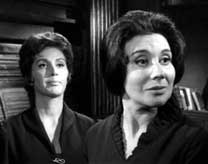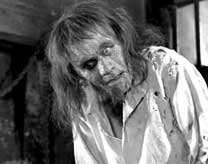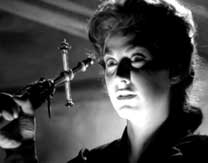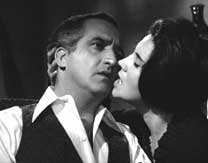One of the most
atmospheric and competently produced efforts in the Mexican horror cannon, THE
CURSE OF THE CRYING WOMAN (original title: “La Maldicion De La Llorona”)
is one of a number of films based on the Mexican folklore legend of “La
Llorona” which literally translates to “The Crying Woman.”
Produced by and starring the legendary Abel Salazar (best known for BRAINIAC
and dozens of other genre films), the movie is best known to American audiences
in a dubbed version distributed by K. Gordon Murray. Casanegra now presents
it in its unedited, original form, and it’s a great addition to any respectable
horror fan’s DVD library.
In the pre-credit sequence, a carriage with three passengers stops in a dark misty forest, encountering a blank-eyed raven-haired woman leashing three Great Danes. She orders her henchman (Carlos López Moctezuma) to mercilessly do away with the trio of travelers, even driving the carriage over a young woman (Julissa, THE SNAKE PEOPLE). Soon after, we learn that the witch-like entity is Selma (Rita Macedo), who has called upon her niece Emily (Rosita Arenas) to collect an inheritance. With her husband Jaime (Salazar), Emily shows up at the crumbling hacienda of her aunt, and is in for a rude awakening of a nightmarish visit. It turns out that the reason for Emily being there is an ancestral curse which calls for her to revive La Llorona, an executed demoness, now a rotted corpse in waiting.
 For
those not familiar with Mexican horror cinema, THE CURSE OF THE CRYING WOMAN
is not a bad place to start, as it’s exemplary of the genre. From the
opening sequence to the notion of awakening an ancient witch, the film was obviously
inspired by Mario Bava’s BLACK SUNDAY, and succeeds at competing with
the Italian gothics of the period. Rafael Baledon’s direction is stylish
throughout, supported by an exceptional, detailed mansion set (including a soaring
bell tower) which is as impressive as anything seen in Hollywood at the time.
The dungeon is cob-web ridden and rat-infested, complete with the flesh-on-the
bones remains of La Llorona. Taking place entirely at night, the film is generous
with the fog machines and several ghoulish visual effects, even employing scenes
from other Mexican horrors (THE BRAINIAC, WORLD OF THE VAMPIRES, THE MAN AND
THE MONSTER, etc) shown in negative to illustrate La Llorona’s history.
For
those not familiar with Mexican horror cinema, THE CURSE OF THE CRYING WOMAN
is not a bad place to start, as it’s exemplary of the genre. From the
opening sequence to the notion of awakening an ancient witch, the film was obviously
inspired by Mario Bava’s BLACK SUNDAY, and succeeds at competing with
the Italian gothics of the period. Rafael Baledon’s direction is stylish
throughout, supported by an exceptional, detailed mansion set (including a soaring
bell tower) which is as impressive as anything seen in Hollywood at the time.
The dungeon is cob-web ridden and rat-infested, complete with the flesh-on-the
bones remains of La Llorona. Taking place entirely at night, the film is generous
with the fog machines and several ghoulish visual effects, even employing scenes
from other Mexican horrors (THE BRAINIAC, WORLD OF THE VAMPIRES, THE MAN AND
THE MONSTER, etc) shown in negative to illustrate La Llorona’s history.
Macedo and Arenas are both beautiful actresses who have done a number of Mexi horrors, and they bring a great presence to this film as their evil and good characters clash. Salazar (who was married to Arenas at one time) had done so many of these types of romps before that he looks very much at home being the leading man (smoking long cigars and fending off flapping rubber vampire bats), taking a backseat to the ladies. Moctezuma, another vet of sinister cinema, is great as the lurking club-footed homely henchman, and Domingo Soler adds another monstrous facet to the proceedings, portraying a hairy, malformed madman (a great make-up job) who is kept prisoner in the hacienda, only to be set loose to wreak havoc. The climax is also a cinematic showcase, as the house of the crying woman literally falls to pieces, and a miniature model of it is surprisingly convincing.
 Casanegra’s
DVD of THE CURSE OF THE CRYING WOMAN looks fantastic, miles above the previous
public domain prints of the U.S. version that have circulated over the years.
The source elements are in flawless shape, making for a crystal clear, clean
image and a great amount of detail. The shadowy images of the black & white
photography can now be fully appreciated. Included is the film’s original
Spanish language track in Dolby Digital mono 1.0, as well the familiar English-dubbed
K. Gordon Murray track. If you’re only familiar with the American version,
you will be delighted to witness extra footage during the Great Danes’
vicious attack on a group of policemen. The menus are accessible in either English
or Spanish.
Casanegra’s
DVD of THE CURSE OF THE CRYING WOMAN looks fantastic, miles above the previous
public domain prints of the U.S. version that have circulated over the years.
The source elements are in flawless shape, making for a crystal clear, clean
image and a great amount of detail. The shadowy images of the black & white
photography can now be fully appreciated. Included is the film’s original
Spanish language track in Dolby Digital mono 1.0, as well the familiar English-dubbed
K. Gordon Murray track. If you’re only familiar with the American version,
you will be delighted to witness extra footage during the Great Danes’
vicious attack on a group of policemen. The menus are accessible in either English
or Spanish.
Extras include an informative commentary (available with Spanish subtitles for non-English speaking audiences) by Mexican cinema expert and VP of Casanegra, Michael Liuzza, who takes the time to discuss the cast, the director and other facets of the production. A text essay on director Rafael Baledon is well-researched and expertly written by David Wilt, and there are equally well-scribed bios on Arenas, Moctezuma, Macedo and Salazar. A still gallery rounds out the extras on the disc, which is also comes with a colorful CasaNegra Loteria game card and a booklet (in both Spanish and English) about the legend of La Llorona, written by Peter Landau. The disc’s cover is reversible in English or Spanish. Casanegra’s next releases will be BRAINIAC and THE BLACK PIT OF DR. M, so we have those and hopefully much more to look forward to! (George R. Reis)